Dashi: the broth at the base of almost every Japanese dish
Dashi (だし) is a broth and cooking stock used in Japanese cuisine. It’s what gives “umami” flavor to Japanese dishes and is used often.
To name a few of my favorite dishes, takoyaki and okonomiyaki are grilled foods that use dashi to form their tasty batter, which is made of flour (making it konamono, or “flour things”).
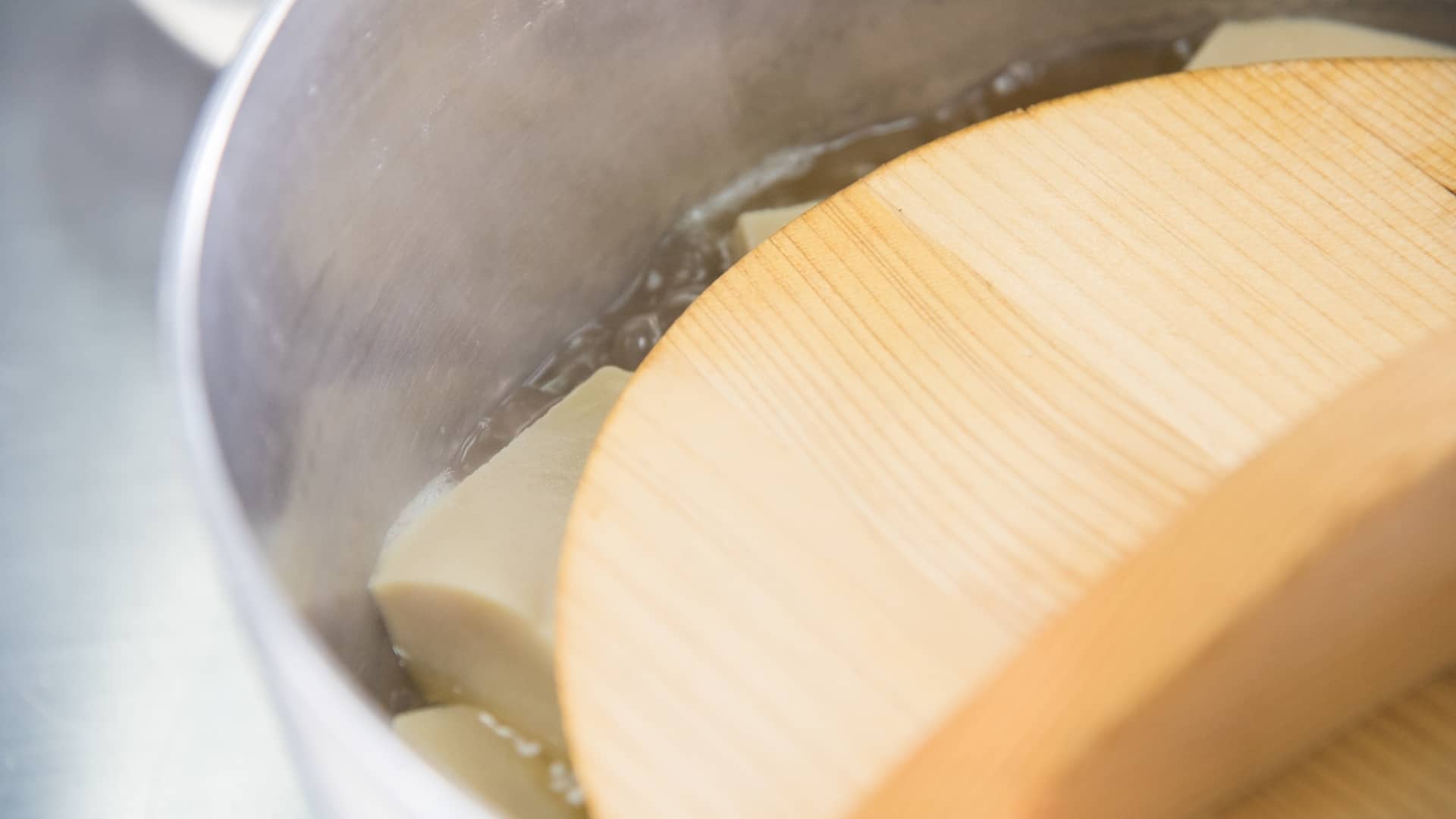

Check out our new cookbook
Bitemybun's family recipes with complete meal planner and recipe guide.
Try it out for free with Kindle Unlimited:
Read for freeIn this post we'll cover:
What is dashi?
Dashi is made by simmering katsuobushi (preserved, fermented bonito tuna shavings, also known as kezuribushi) and kombu (edible kelp) in boiling water for 3 – 5 minutes. Then, it’s strained, leaving only the broth, which is called “dashi.”
Dashi is a base flavor for soups, broths, and stocks. Think of dashi as a bouillon cube, giving flavor to the dish.
Dashi is the parent name for several broths and is often called dashi-jiru (出し汁), which means dashi soup (jiru means soup).
The 2 techniques used for preparing the dashi are:
- nidashi (煮出し, means to extract essence by boiling)
- mizu dashi (cold water extraction, mizu – 水 みず – means water)
The most popular form of dashi is a hot nidashi broth made with kombu and katsuobushi. It is called awase dashi because it combines two ingredients.
The most basic version of the dashi is a vegan broth made by cold-brewing kombu.
Katsuobushi is dried, smoked bonito, which is a kind of tuna. Katsuobushi is often used as flakes shaved from a piece of dried fish.
This is kezuribushi, but we still call it katsuobushi.
You can buy the main ingredients katsuobushi and kombu, on Amazon these days:
| Katsuobushi | Kombu |
|---|---|
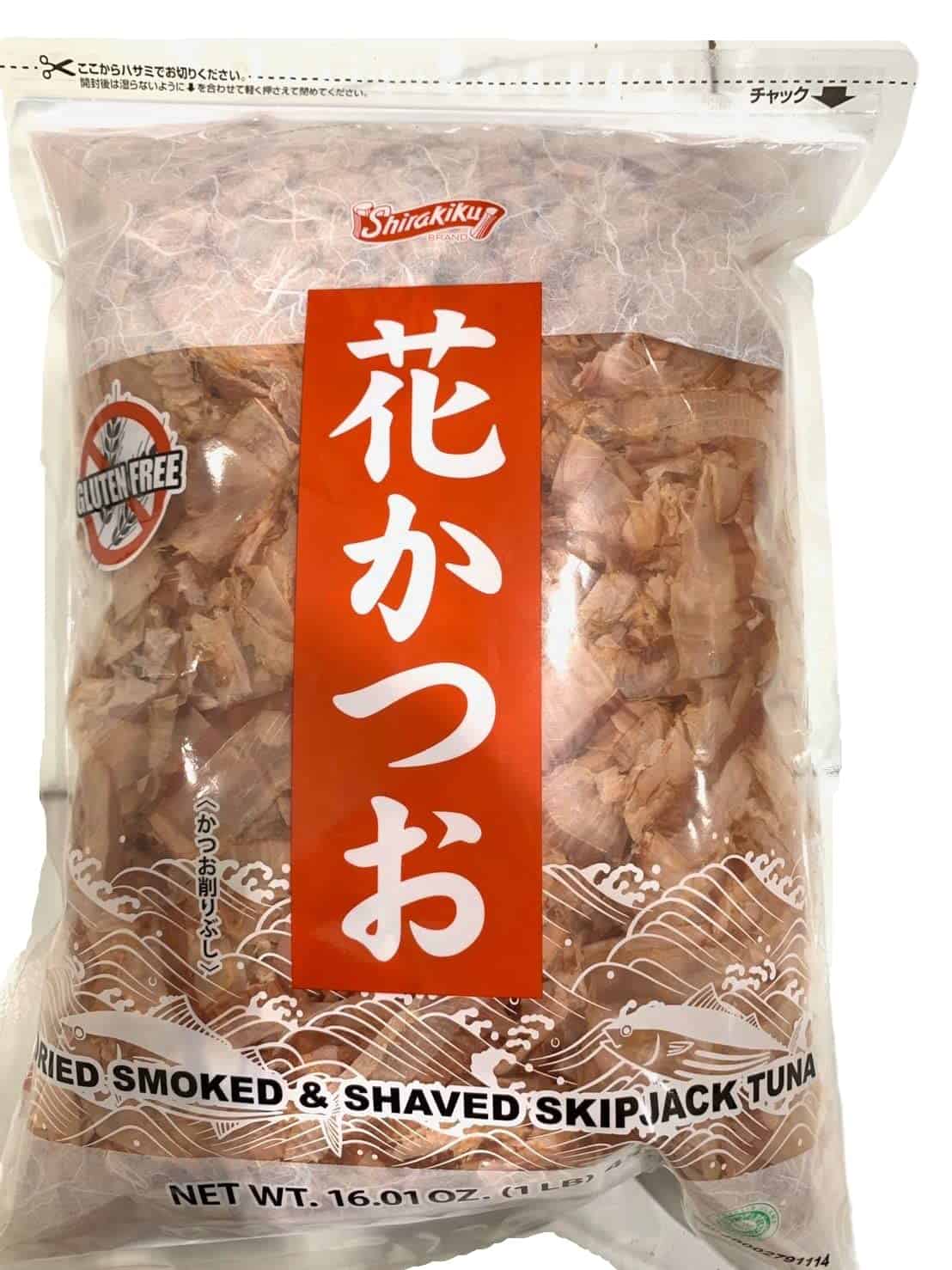 | 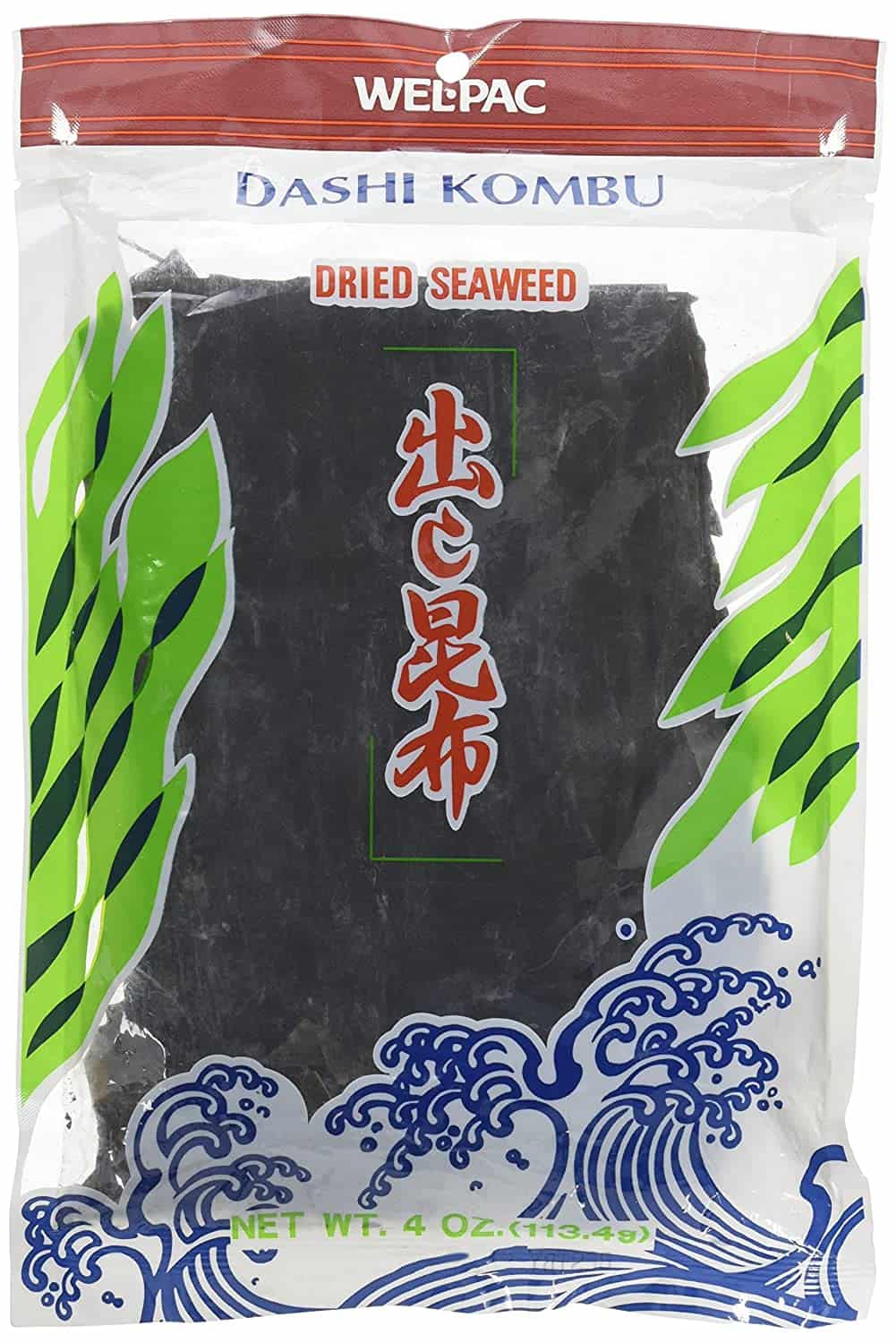 |
| (view more images) | (view more images) |
Types of Japanese Dashi
There are different types of dashi, some are vegan and made from mushrooms and kombu (kelp), and most have bonito flakes (fish) or dried bonito powder.
There are different types of dashi which can all be made in the nidashi or mizu dashi type of cooking:
Kombu Dashi
Kombu dashi uses just two ingredients, pure water and kombu kelp, making it an excellent broth option for vegans and vegetarians.
Using the nidashi technique, you must first place the kombu kelp in a pot of cold water. Then allow it to sit there for about 30 minutes – 3 hours.
Afterward, place it on top of the stove and boil the water over medium heat. Meanwhile, skim the water’s surface in order to remove any foam and keep the broth clear.
Remember to take out the kombu from the pot just before the water starts to boil. If you don’t, the dashi stock may taste bitter and slimy.
After boiling the dashi, strain the broth through a sieve to remove any foam or pieces.
If you want to extract the dashi from kombu via cold water extraction, then cut a steep piece of kombu kelp. Next, put it in a small water container, and refrigerate it overnight.
Once done, you can pour the dashi stock into a bottle container and use it sparingly on multiple dishes.
You will notice a clear, lightly colored broth with a deep umami flavor.
You can also make dashi without kombu, here are 7 easy ways to do it
Iriko/Niboshi Dashi
Iriko dashi (also called niboshi dashi) is another kind of dashi made by mixing anchovies or baby dried sardines and water.
This dashi has a deep fishy flavor than the others and is preferred in the eastern Kanto region in Japan as it came from a tradition of fishing folks.
You can make the iriko dashi by simply putting baby dried sardines or anchovies in a pot with 2- 4 cups of water in it, bringing it to boil, and waiting until the scent of the fish emerges.
When that happens, then this means that the dashi is ready.
It is believed by some people that the head and innards of dried fish cause the dashi to become bitter, so they remove it. Others don’t mind it and boil the dried fish as a whole.
And as for the dried fish in the dashi, you can strain them through a sieve to remove them from the broth or leave them as is.
Shiitake Dashi
Shitake dashi is made from dried shitake mushrooms. It is famous in Japan, and many vegetarians or vegans prefer it because it adds a strong salty flavor to the dashi.
This dashi doesn’t need boiling and all you have to do is to soak the dried shiitake mushrooms in lukewarm water.
It is not recommended that you use water that’s been heated to almost or at its boiling point. This may prevent the shitake mushroom from releasing the much-needed savory umami flavor.
Unlike the kombu dashi though, the shitake dashi has a dark brown color to the broth.
Some people mix shitake dashi and kombu dashi to get the best of both flavors.
Also read: different kinds of Japanese soups you can make with these recipes
Bonito/Katsuo (Awase Dashi)
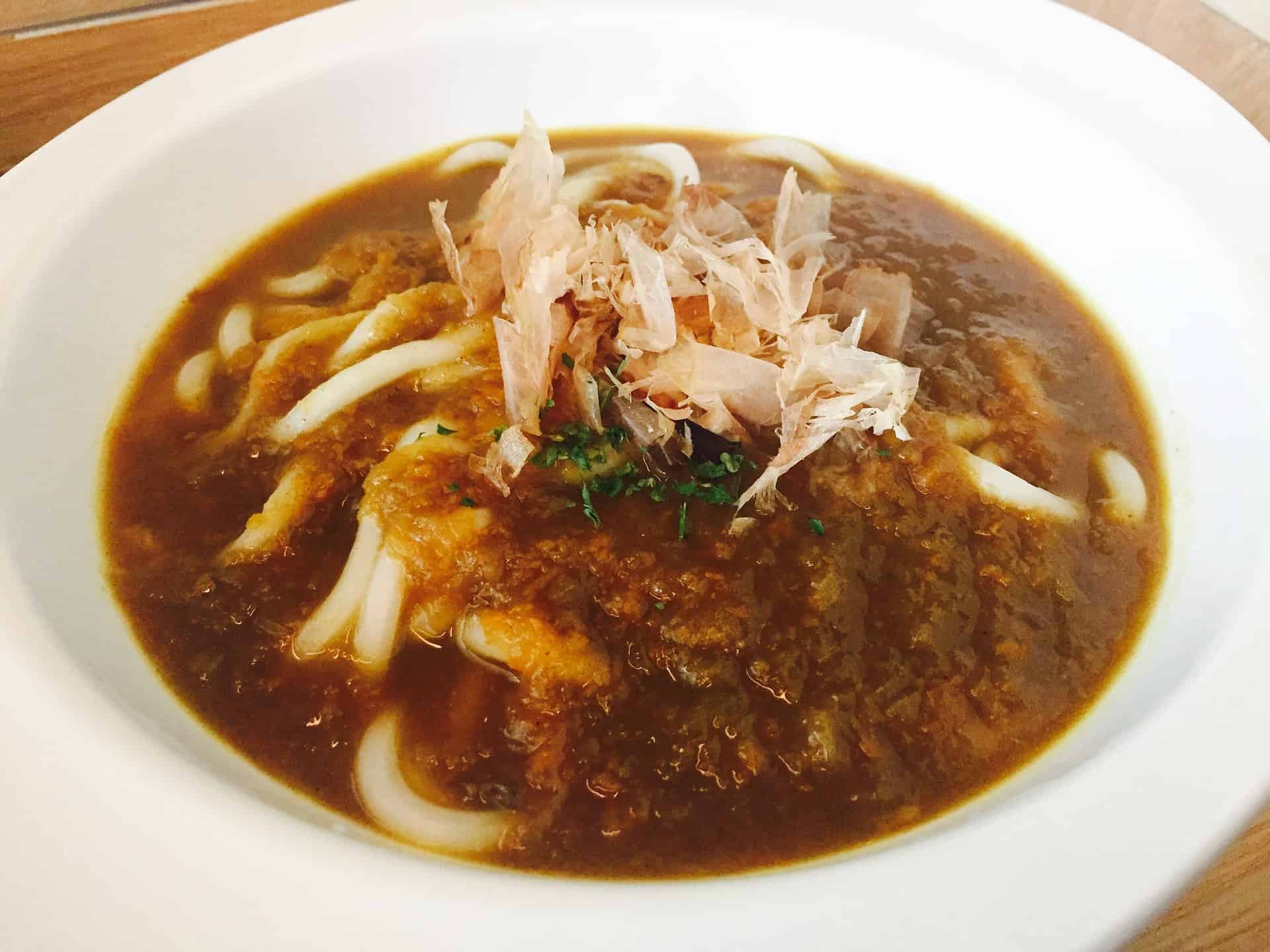
Awase dashi is the most common name for dashi these days.
The awase dashi has a more complex flavor when compared to other dashi types. It is made out of a combination of katsuobushi (bonito fish flakes) and kombu kelp.
First, you extract the kombu dashi by using the nidashi method.
Check the pot regularly when you’re simmering the kombu. Wait until the water is almost at its boiling point, then remove the kombu. After that, add the bonito fish flakes to enhance the flavor.
As soon as the pot comes to a boil, turn off the stove. Allow the dried fish flakes to absorb the broth for a few minutes.
Make sure to check if the flakes have already sunk to the bottom of the pot before straining the broth.
It should have a delicate taste to it with a cadmium-like yellow tinge to it and a refined flavor.
You can keep the kombu and bonito flakes to make more dashi. The resulting dashi will actually have a stronger flavor than the first one.
What does Dashi taste like?
Most people describe dashi as a combination of marine flavors and glutamic acids, which provide it with that umami flavor.
It tastes savory and has different flavors of seafood. It is salty but has the flavors of seaweed and dried fish.
The high content of sodium inosinate in the katsuobushi and the glutamic acids in the kombu create a synergy of umami that’s very appealing to the taste buds on the tongue, which is why most people love it.
Combining the flavors of katsuobushi and kombu in the broth unleashes the element of umami (one of the five basic tastes) into the dashi.
Dashi is commonly used as a base for soups, curries, stews, and even a component in dipping sauce and batter.
However, homemade dashi is no longer that popular these days.
Even in Japan, it’s been replaced by granulated or liquid instant dashi since the end of WWII (read all about the history of dashi here).
The added glutamates and ribonucleotides (which are chemical flavor enhancers in the instant dashi) are preferred by chefs since they have a stronger and less subtle flavor compared to homemade dashi.
I don’t make my own anymore and prefer to use this Ajinomoto HonDashi for its rich flavor:
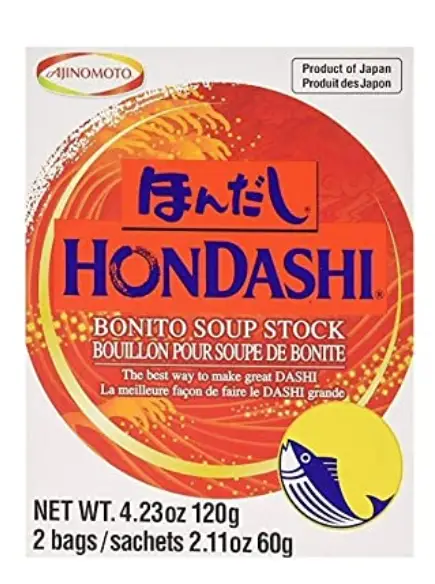
There are also other variations of dashi stock that include soaking shiitake, niboshi, or kelp in plain water for long hours to extract their flavors or simmering them in hot water (70 – 80° Celsius) and then straining the broth that you get out of it.
Kikunae Ikeda, a chemistry professor at Tokyo Imperial University, discovered the unusual and strong flavor of kelp dashi in 1908 and identified it as the “fifth flavor” of umami.
According to him, the glutamic acid found in the kelp in dashi stimulates a specific human taste receptor.
What is “umami” in dashi?
Umami is one of the five basic tastes that the human taste receptors react to and roughly translates as “pleasant savory taste”.
It’s one of these five taste types:
- sweet
- sour
- bitter
- salty
- umami
It’s been described as savory and is characteristic of broths and cooked meats.
Believe it or not, until dashi was invented, scientists didn’t know that humans had a specific taste receptor that reacts to the glutamate in dashi!
In essence, Professor Kikunae Ikeda discovered both umami and the glutamic taste receptor in the tongue. It was also Professor Ikeda that coined the term.
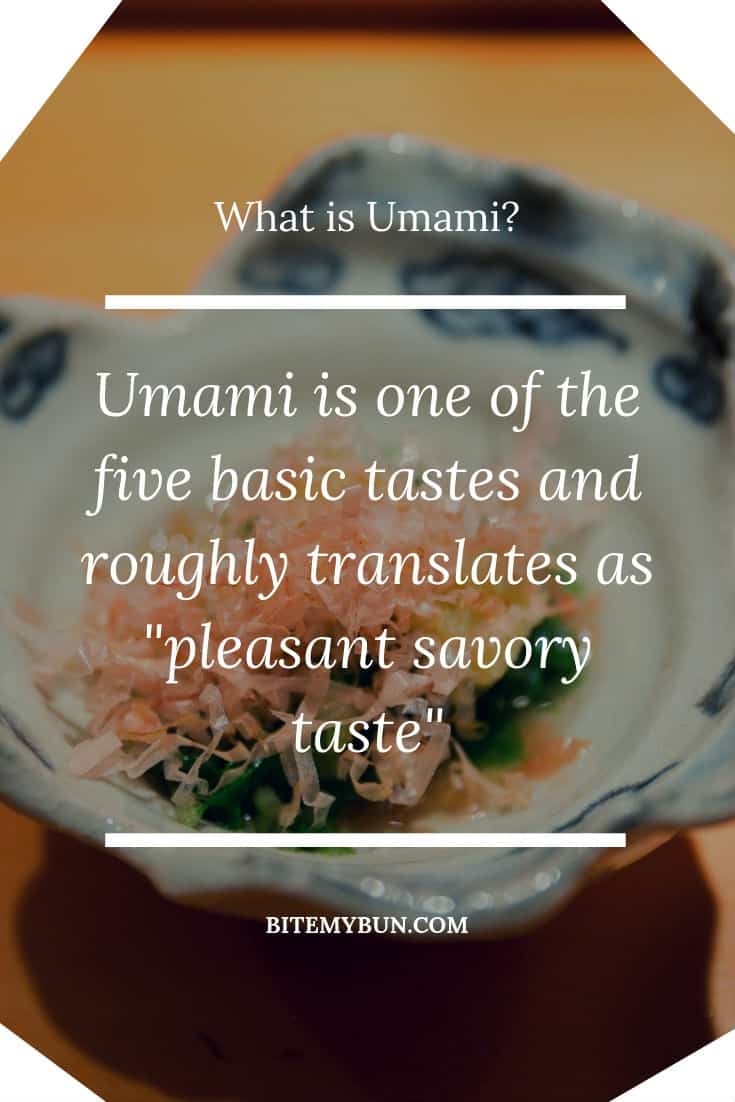
This is a text overlay image of the original work Japanese green vegetable, dried bonito flakes, herring roe by City Foodsters on Flickr under cc.
Origins of Dashi
Dashi is the cooking broth at the heart of Japanese cuisine.
Although it may not look like much, this clear broth is imbued with one of the five basic tastes called umami (savory).
The dashi adds richness and depth to any recipe you cook, which is why Japanese chefs always keep this stock in their kitchen.
Approximately 800 years ago in Japan, the cooks started experimenting with kombu (a type of kelp) and mixing it with pure spring water. The kombu contains glutamate from which the dashi’s umami’s flavor is derived.
It’s amazing to know that making the dashi is incredibly simple, yet it is used in half of all Japanese cuisines!
Kelp and bonito were combined in the mid-Edo period to create the modern-day dashi. This food base was most used in the Kansai region around Osaka.
The Japanese use dashi because it’s so easy to make and cook with! Just boil water and add kombu plus some dried bonito flakes, and the broth that results from that combination is your dashi stock (bonito is a fish that evolved from tuna fish).
The dashi stock can be prepared in about 30 minutes or so, which is faster than the Western stocks that normally take a couple of hours to cook.
It is practically impossible to truly appreciate Japanese cuisines without the dashi as any other substitute for the dashi doesn’t come close to bringing out the authentic flavor of the dishes when dashi is present in the ingredients.
Every culture has some sort of ingredient that is an integral part of its cuisine.
Japan is no exception to this simple fact, and one ingredient that is in a lot of their food is a soup stock known as dashi.
But what is the exact origin of dashi? Did someone invent it one fateful day? Or was it something that just developed over time?
Dashi in Ancient Japan
While there were early references to the ingredients of dashi back in 700 AD, dashi did not appear in a physical cookbook until sometime during the Edo period of Japan (1603 AD – 1868 AD).
It was during the 1800s, near the end of the Edo period, that dashi gradually became more commonplace and was used as a stock in many different kinds of soup.
There is no clear indication that any individual invented dashi as an ingredient.
Rather, it appears that dashi gradually developed as people experimented with ingredients while making meals.
A lot of soups, especially miso soup, relied upon dashi as a base ingredient. It is also used in ramen and udon noodle soups as well and in sauces like mentsuyu.
Advancements with dashi mainly occurred in the Kansai region of Japan.
All the main ingredients of dashi, kelp, and fish flakes (often tuna or sardines) passed through this area of Japan from other regions.
As a result, with all of these ingredients in one place, dashi began to develop more and more.
Also read: are ramen noodles Chinese or Japanese?
Has dashi changed over the years?
Dashi as a soup stock has not changed much over the years.
The same ingredients are used, but the methods and techniques for making it have certainly evolved as technology allowed for all kinds of innovations.
Making dashi is time-consuming, but nowadays, it is possible to buy instant dashi stock in a grocery store.
This instant dashi is comparable to bouillon cubes that are often used to save time when making anything that needs stock. But it comes with its drawbacks, which I will discuss later.
Here’s how to tell dashi apart from other fish-based anchovy broth, which is much more pungent in taste.
Dashi, the historical and versatile backbone of Japanese cuisine
Though there is no specific point in history that dashi was invented in Japan, it is at the core of many Japanese recipes and culture.
When dashi became commonplace, it allowed the Japanese cuisine culture to grow and develop into what it is today.
Also read: how to use one of these dashi powder substitutes in your dishes
Popular pairing with dashi
Like most Japanese broths and soups, dashi broth pairs great with savory, fortified liquids like wine.
They not only serve as a great siding on their own but bring the pure umami ness out of dashi in its raw intensity.
The most common wine paired with dashi is Fino, prepared from Palamino grapes and has a transparent, white color.
However, any wine that has a salty and savory touch to it will work if you can’t seem to find Fino.
My best pick after Fino would be manzanilla, though.
Despite that, it has a more fresh and bright touch to its taste, with just the right amount of saltiness to enhance the already delicious flavor of dashi.
Looking for cooking inspiration? Here are 8 easy and popular recipes to make with dashi stock
Is dashi healthy?
This depends on whether you are making authentic dashi with the original ingredients or a pack of one of those stock powders readily available in the western markets.
To make my point more elaborate, let’s have a look at both:
Authentic dashi
Though the kombu used in the authentic recipe still has MSG in it, it’s in a reasonably optimum amount and won’t harm your health.
Hence, homemade dashi is safe for daily use and has, in fact, a lot of health benefits associated with it.
For example, bonito flakes and kombu are rich in amino acids that aid digestion.
Moreover, the iodine and enzymes found in the ingredients are also helpful in promoting thyroid health and blood pressure regulation.
Dashi also regulates proper blood flow to the brain, significantly improving mental health.
However, just because it’s safe and healthy doesn’t mean you should eat it frequently. Even the “good” things can be poison in excess… if you know what I mean. ;)
Also read: Is teriyaki healthy? It depends on how you make it!
Dashi powder
Dashi powder is a readily available ingredient to flavor Japanese dishes that require a little umaminess. However, unlike the original dashi ingredients, it contains a hell lot of MSG,
Now the status of MSG is quite ambiguous on the safety scale. Some researchers found it associated with metabolic disorders and insulin resistance.
At the same time, authorities like FDA call it a “safe” food additive.
The advocates of MSG put forth many arguments to dismiss the reports, calling the experimental data and method flawed.
They also say that the experiments on animals were restricted to injections instead of oral doses, directly releasing the substance into the bloodstream, which isn’t how it’s used.
Now, these seem like valid points.
However, since the substance is still under observation, I would be slightly worried about consuming it regularly.
As for occasional use, I would always keep it in my cabinet as a second choice just in case I wasn’t lucky to find a kombu leaf.
FAQs
Is dashi the same as fish sauce?
While there’s fish in dashi, it’s not the same as fish sauce.
Fish sauce is often made from anchovies, salt, and water and has a strong salty taste. Dashi is made from seaweed (kombu) and fermented, dried tuna (bonito flakes).
Is dashi the same as bonito flakes?
Dashi is not the same as bonito flakes. Rather, bonito flakes are one of the ingredients for making dashi, next to dried seaweed (kombu).
Is dashi the same as miso?
Miso is not the same as dashi, though they’re both used to make miso soup.
Dashi is a broth made from dried fermented tuna and dried sheets of seaweed, and miso is a paste made from fermented soybeans.
Dashi is not the same as dashima as dashi is a Japanese broth made from katsuobushi and kombu and dashima is the Korean name for that kombu. This edible kelp is cultivated in both Japan and Korea.
How long does dashi last in the fridge?
You don’t have to use all of your dashi at once, right after you’ve made it. You can save dashi in a closed container, but you have to put it in the fridge.
It’ll keep for around 7 days, or you can keep it in the freezer, where it’ll last three weeks.
Can you buy dashi at the grocery store?
Unfortunately, you can’t buy Dashi at the normal grocery store. Even most Asian grocery stores don’t sell it!
However, you can purchase dashi from most Japanese stores and a wide variety of online stores that deliver across America.
You can buy Hon dashi stock, which is great:
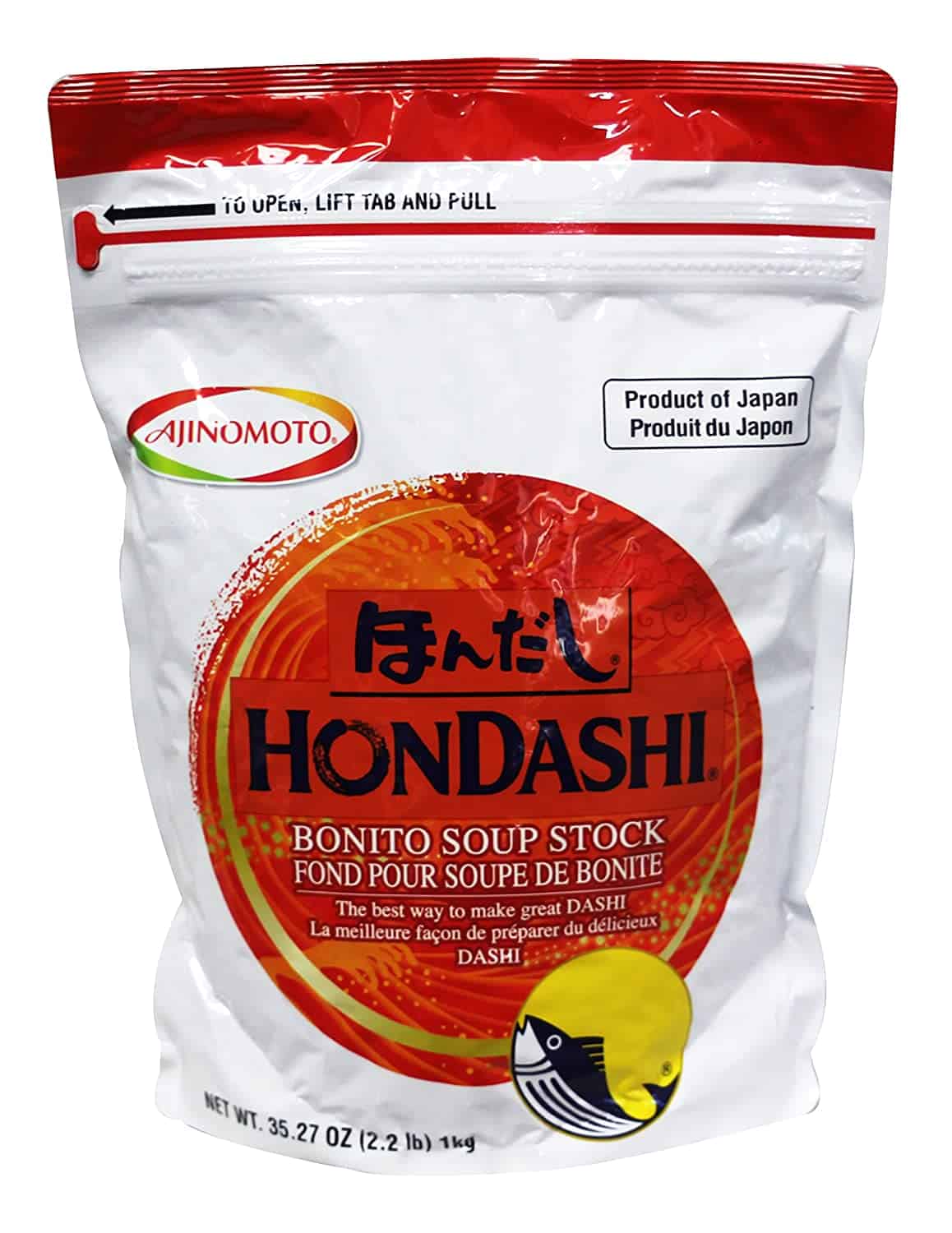
Is Dashi the same as miso?
Many people confuse dashi and miso. Both may be used as base flavors for soups and stocks, yet they are made from different ingredients.
Dashi is made with seaweed combined with smoked and dried fish, known as bonito. The Japanese make miso out of soybeans combined with rice or barley, depending on the type.
Therefore, note that miso and dashi taste different.
Dashi contains no alcohol because it’s made from water, katsuobushi, and kombu. It might be added to dishes that also use ingredients that contain alcohol, like sake or mirin, but the dashi itself does not.
How do I store Dashi? Does it go bad?
You can make a big pot of instant dashi (check the water to granules ratio here) and store it in the refrigerator for approximately 3 days. It goes bad after about 3 days, so make sure to use it up.
As for the dashi powders, cubes, and sauces, you can store them in the pantry for at least six months.
If the packet is open, close it tight and use it within a week, so it doesn’t absorb too much moisture.
Conclusion
Given the unique flavor of dashi and its prevalent use as a base stock for almost more than half of Japanese dishes, Japanese cuisine is incomplete without it.
The umami flavor dashi gives to soups and stews has almost become a synonym for authentic Japanese taste, and there are very few dishes in Japan that don’t use dashi in some form.
It also serves as a great flavor enhancer for our vegetarian friends who want to give some tasty twist to their daily diet without carnivore ingredients. Not to mention all the health benefits it comes with.
In this post, I tried to cover everything about this unique stock, from its history and origin to its uses and substitutes and anything in between. I hope this piece has been both helpful and informative.
Have you tried dashi yet? If not, I would highly recommend you to. You are going to fall in love with it, trust me. ;)
Check out our new cookbook
Bitemybun's family recipes with complete meal planner and recipe guide.
Try it out for free with Kindle Unlimited:
Read for freeJoost Nusselder, the founder of Bite My Bun is a content marketer, dad and loves trying out new food with Japanese food at the heart of his passion, and together with his team he's been creating in-depth blog articles since 2016 to help loyal readers with recipes and cooking tips.
